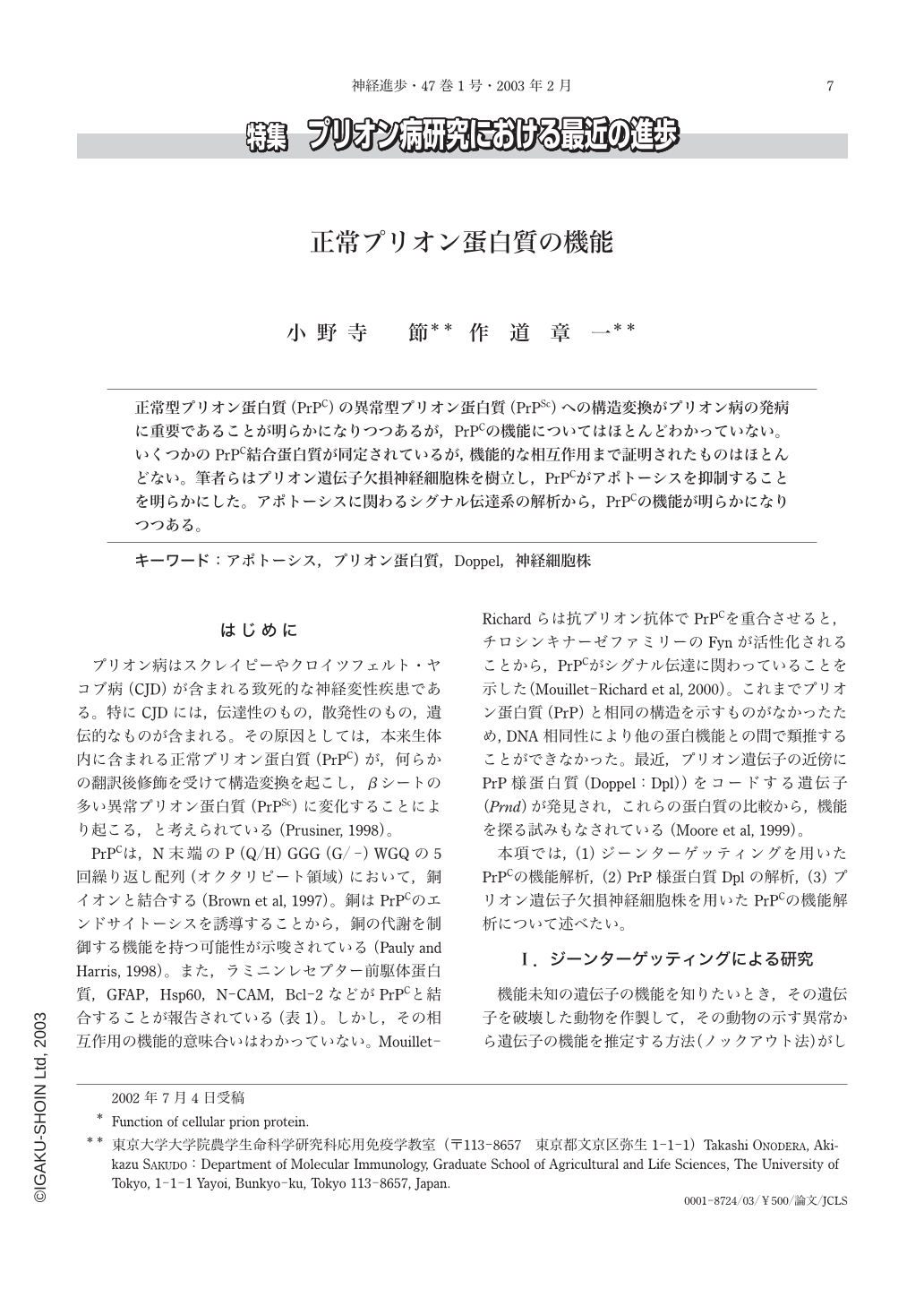Japanese
English
- 有料閲覧
- Abstract 文献概要
- 1ページ目 Look Inside
正常型プリオン蛋白質(PrPC)の異常型プリオン蛋白質(PrPSc)への構造変換がプリオン病の発病に重要であることが明らかになりつつあるが,PrPCの機能についてはほとんどわかっていない。いくつかのPrPC結合蛋白質が同定されているが,機能的な相互作用まで証明されたものはほとんどない。筆者らはプリオン遺伝子欠損神経細胞株を樹立し,PrPCがアポトーシスを抑制することを明らかにした。アポトーシスに関わるシグナル伝達系の解析から,PrPCの機能が明らかになりつつある。
はじめに
プリオン病はスクレイピーやクロイツフェルト・ヤコブ病(CJD)が含まれる致死的な神経変性疾患である。特にCJDには,伝達性のもの,散発性のもの,遺伝的なものが含まれる。その原因としては,本来生体内に含まれる正常プリオン蛋白質(PrPC)が,何らかの翻訳後修飾を受けて構造変換を起こし,βシートの多い異常プリオン蛋白質(PrPSC)に変化することにより起こる,と考えられている(Prusiner, 1998)。
PrPCは,N末端のP(Q/H)GGG(G/-)WGQの5回繰り返し配列(オクタリピート領域)において,銅イオンと結合する(Brown et al, 1997)。銅はPrPCのエンドサイトーシスを誘導することから,銅の代謝を制御する機能を持つ可能性が示唆されている(Pauly and Harris, 1998)。また,ラミニンレセプター前駆体蛋白質,GFAP,Hsp60,N-CAM,Bcl-2などがPrPCと結合することが報告されている(表1)。しかし,その相互作用の機能的意味合いはわかっていない。Mouillet-Richardらは抗プリオン抗体でPrPCを重合させると,チロシンキナーゼファミリーのFynが活性化されることから,PrPCがシグナル伝達に関わっていることを示した(Mouillet-Richard et al, 2000)。これまでプリオン蛋白質(PrP)と相同の構造を示すものがなかったため,DNA相同性により他の蛋白機能との間で類推することができなかった。最近,プリオン遺伝子の近傍にPrP様蛋白質(Doppel:Dpl))をコードする遺伝子(Prnd)が発見され,これらの蛋白質の比較から,機能を探る試みもなされている(Moore et al, 1999)。
本項では,(1)ジーンターゲッティングを用いたPrPCの機能解析,(2)PrP様蛋白質Dplの解析,(3)プリオン遺伝子欠損神経細胞株を用いたPrPCの機能解析について述べたい。
The function of normal cellular isoform of prion protein(PrPC)remains unknown. Although many PrPC-binding proteins have been reported, functional interaction of these proteins is not authenticated. Doppel(Dpl), a recently discovered prion protein(PrP)-like protein, might provide new approaches to PrPCfunctions, because overexpression of Dpl causes apoptotic cerebellar cell death that is inhibited by PrPC, indicating functional interaction between PrPCand Dpl. Recently, we have established a line of PrP-deficient immortalized hippocampal neuronal cell lines(HpL2-1, HpL3-2, HpL3-4 and HpL4-2)derived from Rikn PrP-knockout mice. Serum removal from the cell culture causes apoptosis in PrP gene(Prnp)-deficient cells(Prnp-/-cells), but not in Prnp+/+cells. Transfection of Prnp suppresses apoptosis of the Prnp-/-cells under serum-free conditions. Investigation of apoptosis cascade induced by serum deprivation in Prnp-/-cells would elucidate the function of PrPC.

Copyright © 2003, Igaku-Shoin Ltd. All rights reserved.


